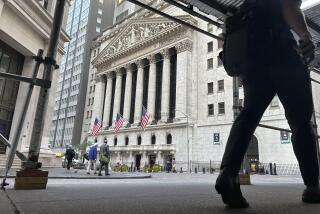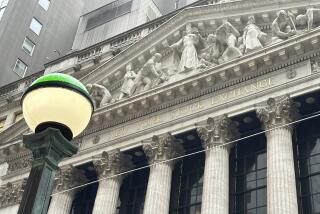Prospect of Dip in Economy Boosts Bonds
NEW YORK — Bond prices continued to climb Tuesday, with the strongest gains concentrated among long-term Treasury securities.
The yield on the Treasury’s 30-year bond slid to 7.9% from 8% late Monday. The price of the bond surged about $13 for each $1,000 in face amount. Bond prices and yields move in opposite directions.
At the same time, Wall Street set off some new bull market fireworks as stocks ran up their second biggest gain ever, carrying all the major market averages to new highs.
Speculation that the government will release some weak economic news this week triggered bond buying. The reports on February’s retail sales and industrial production are due Thursday and Friday, respectively.
The economy’s lethargy could persuade the Federal Reserve Board to drive interest rates lower in an effort to spur activity, some analysts say.
Interest rates might head lower even if the Fed doesn’t alter its policy, some analysts say.
In the secondary market for Treasury securities, prices of short-term governments rose from 3/32 point to 3/16 point and intermediate maturities were up 3/16 point to 22/32 point. The 20-year bond spurted 1 points and the 30-year issue jumped 1 3/8 points, according to the investment firm of Salomon Bros.
The movement of a point is equivalent to a change of $10 in the price of a bond with a $1,000 face value.
In the market for corporate securities, industrials rose 1/2 point in moderate trading and utilities rose 3/8 point in light activity.
Among tax-exempt municipal bonds, general obligations and revenue bonds gained 1/2 point in quiet dealings.
Yields on three-month Treasury bills fell two basis points to 6.58%. Six-month bills edged up one basis point to 6.56%, and one-year bills were also up one basis point to 6.58%.
The federal funds rate--the interest on overnight loans between banks--traded at 7.563%, compared to 7.375% late Monday.
In stock trading, the Dow Jones average of 30 industrials jumped 43.10 to 1,746.05, its biggest gain in points since it soared a record 43.41 on Nov. 3, 1982. The previous closing high for the average had been 1,713.99 on Feb. 27 of this year.
Along with the various measures of New York Stock Exchange issues, indexes for the over-the-counter market and the American Stock Exchange hit new peaks.
Standard & Poor’s index of 400 industrials chimed in with a 5.96 gain to 255.33, and S&P;’s 500-stock composite index was up 5.11 at 231.69.
The NASDAQ composite index for the over-the-counter market rose 3.43 to 367.36. At the Amex, the market-value index closed at 264.15, up 3.37.
Big Board volume came to 187.27 million shares, the fifth-largest total ever, against 129.93 million on Monday.
In the daily tally on the Big Board, advancing issues outnumbered declines by more than three to one. The exchange’s composite index gained 2.71 to 133.58.
Depressed energy stocks joined in the upsurge after prices of crude oil futures turned upward Monday and early Tuesday. Also, the oil group received an endorsement from at least one brokerage firm.
More to Read
Inside the business of entertainment
The Wide Shot brings you news, analysis and insights on everything from streaming wars to production — and what it all means for the future.
You may occasionally receive promotional content from the Los Angeles Times.










